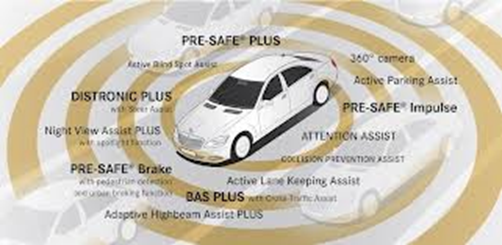Another creative technology from an iconic brand name, Mercedes Benz has introduced a significant expansion of its “Intelligent Drive” to improve safety and specifically help drivers avoid a crash. The suite of active-safety technologies uses a combination of radar arrays, cameras, proximity sensors and physical signals to the driver–all in the interest of avoiding accidents and lessening the damage done by the unavoidable ones.
At the center of all this digital and physical action happening in the name of occupant safety and accident prevention is the creative use of selective braking. The vehicle can activate all four brakes at each wheel at maximum capacity, even beyond the level asked for by the driver with his or her foot.
While this alone is not unique, what is new and unique is the ability to activate only one single wheel’s brake or only a pair on one side of the car. These strategies enable the car to stop, or direct itself in ways not possible by a normal driver, or even a trained professional. Available as a $2,800 option on the 2014 S-Class sedans and the E-Class sedans, wagons and convertibles, these systems add a large dose of safety through technology. The below highlights two of the most significantly revised technologies / features within Mercedes‘ overall Intelligent Drive package.
1. Cross-Traffic Assist
Imagine a car that can increase braking force as soon as the driver applies the brakes to lessen, or possibly, prevent a collision, all based on electronic sensory input. Impressive. While this “Brake Assist Plus” in Mercedes parlance is not new to Mercedes, the new factor is the ability to see crossing traffic and activate itself under these conditions through the use of two windshield-mounted cameras that recognize potentially dangerous traffic situations. Pedestrians and bicycles are recognized by the system, too.
Those two windshield-mounted cameras are coupled to three radar arrays, all of which read movements in intersections. If the driver applies the brakes, but not hard enough, the car applies additional brake pressure. How much additional pressure varies based on a variety of parameters. It can bring the car to a complete stop, if possible and needed. It is not a guarantee of accident avoidance, but it’s the closest thing to it.
2. Lane Keeping Assist
Active lane keeping (part of Mercedes’ Distronic Plus cruise control system) prevents the car from leaving the lane unintentionally and works not just when traveling in a straight line, but also works while in turns.
Rather than intervening by correcting the car’s direction through steering, Lane Keeping Assist works by applying brakes only on one side of the car. For example, if the car is in the right lane on two-laned road and the driver starts to creep right and encroach the solid line which marks the road’s shoulder, the left-side brakes – and only the left-side brakes – are actuated just enough to move the car back into the intended lane. A visual warning lights up in the instrument cluster when the system is activated.
Intelligent Drive amounts to the most sophisticated suite of safety systems in production. And that deserves AOL Technology of the Year recognition.



